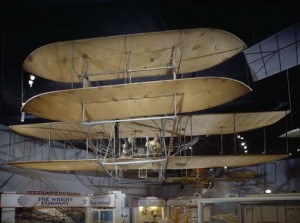The World War II History of the Wright Military Flyer
The two-seat biplane looks somewhat flimsy. Sure, it was cutting-edge in 1909 when the Wrights demonstrated it for the U.S. Army Signal Corps at Fort Meyer. But how would it fare during World War II?Fortunately, the Wright Military Flyer never had to compete in any dogfights. But it did travel from…

The two-seat biplane looks somewhat flimsy. Sure, it was cutting-edge in 1909 when the Wrights demonstrated it for the U.S. Army Signal Corps at Fort Meyer. But how would it fare during World War II?
Fortunately, the Wright Military Flyer never had to compete in any dogfights. But it did travel from Washington, D.C. to Shenandoah National Park in Virginia for the war's duration.
During 1939 and 1940, as reports from Europe described the destructive power of the Luftwaffe’s bombing campaigns, U.S. federal agency heads met to discuss the protection of the nation’s cultural treasures, should bombing reach U.S. shores. By early 1941, most agencies (including the Library of Congress and the Smithsonian Institution) had completed surveys of their historic materials.
With the December 7, 1941 attack on Pearl Harbor, the situation took on a new urgency. The Committee on Conservation of Cultural Resources asked the Works Progress Administration to conduct a nationwide survey of available storage space.
At the Smithsonian, the Institution’s Air Raid Warden organized personnel into roof spotters, fire fighters, demolition squads, and stretcher-bearer units. A special telephone line was installed so the Institution could receive official air raid signals. (Someone had a bit of fun during this tense time; the Smithsonian Archives has in its collection a memo labeled “What To Do In An Air Raid,” which offers this tip: “Take advantage of opportunities afforded you when air raid sirens sound the warning of attack, i.e. (a) If in a bakery, grab a pie or cake. (b) If in a tavern, grab a bottle. (c) If in a movie, grab a blonde.”)
Shenandoah National Park offered the Smithsonian the use of a stone warehouse—with 18-inch-thick walls—for storing its collections. It was an ideal spot; the park was 80 miles from Washington, D.C., far from anything that might be considered a military objective, yet close enough for curators to check the collections frequently. Preparing the warehouse for its new use took until 1942.
One of the evacuated items was the Wright Military Flyer, the world’s first military airplane. More than 60 tons of irreplaceable objects were moved, including "strange animals from all parts of the world, curious creatures from the depths of the sea, plants from China, Philippine Islands, South America and so on, historical objects of great importance, as well as curious types of ancient automobiles, parts of early airplanes, etc.," wrote Assistant Secretary Alexander Wetmore in 1942. The materials were under 24-hour guard for the duration of the war, protected against possible sabotage, theft, or fire. All were returned safely to the Smithsonian at war's end.